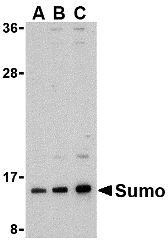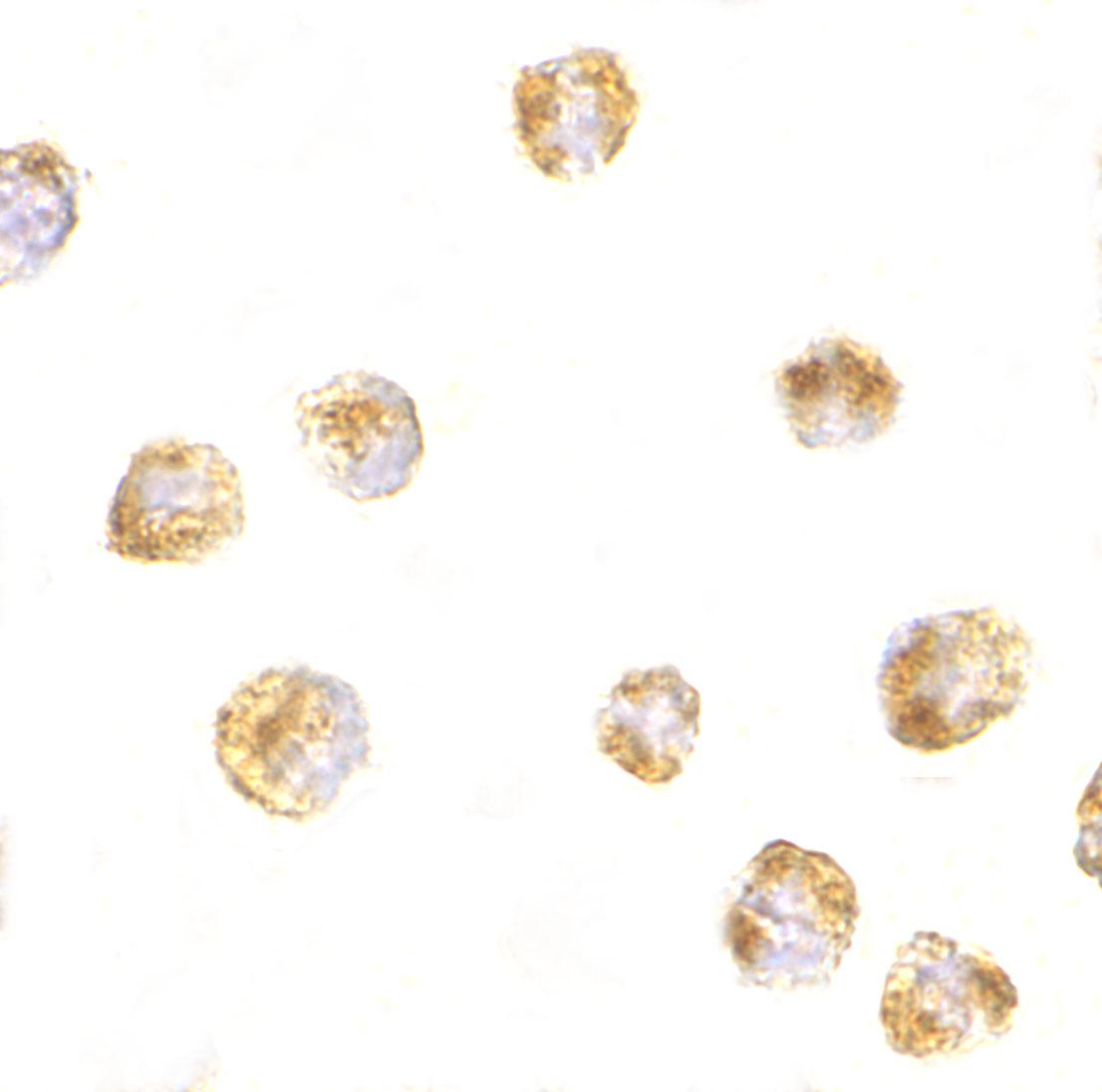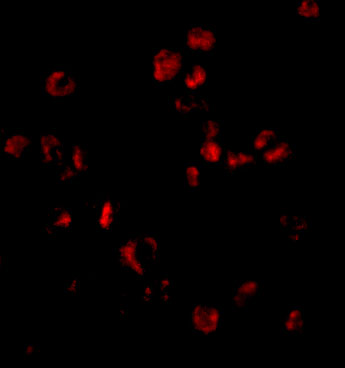Sumo Antibody
| Code | Size | Price |
|---|
| PSI-3969-0.02mg | 0.02mg | £150.00 |
Quantity:
| PSI-3969-0.1mg | 0.1mg | £449.00 |
Quantity:
Prices exclude any Taxes / VAT
Overview
Host Type: Rabbit
Antibody Isotype: IgG
Antibody Clonality: Polyclonal
Regulatory Status: RUO
Applications:
- Enzyme-Linked Immunosorbent Assay (ELISA)
- Immunofluorescence (IF)
- Immunohistochemistry (IHC)
- Western Blot (WB)
Images
Documents
Further Information
Additional Names:
Sumo Antibody: DAP1, GMP1, PIC1, SMT3, UBL1, OFC10, SENP2, SMT3C, SMT3H3, OK/SW-cl.43, Small ubiquitin-related modifier 1, GAP-modifying protein 1, SUMO-1
Application Note:
Sumo antibody can be used for detection of sumo by Western blot at 0.5 - 2 μg/mL. Antibody can also be used for immunohistochemistry starting at 5 μg/mL. For immunofluorescence start at 20 μg/mL.
Antibody validated: Western Blot in human samples; Immunocytochemistry in human samples and Immunofluorescence in human samples. All other applications and species not yet tested.
Antibody validated: Western Blot in human samples; Immunocytochemistry in human samples and Immunofluorescence in human samples. All other applications and species not yet tested.
Background:
Sumo Antibody: The sumo family of proteins is related both structurally and functionally to ubiquitin in that they are post-translationally attached to the e-amino group of a lysine residue of the substrate protein. This sumoylation plays a number of roles in DNA replication and repair, protein targeting to various subnuclear structures, and the regulation of numerous cellular processes including the inflammatory response in mammalian cells. Sumo was initially identified as a covalent modification of RanGAP1 in studies on nuclear import in mammalian cells. More recently, sumo has been shown to be involved in the regulation of transcription factors, possibly by enhancing their interactions with co-repressors. Sumo is also thought to play some role in the modulation of ubiquitin-mediated degradation of proteins by acting as an inhibitor. At least four different isoforms of sumo are known to exist; Sumo antibody will only recognize isoform 1.
Background References:
- Dohmen RJ. Sumo protein modification. Biochim. Biophys. Acta 2004; 1695:113-31.
- Matunis MJ, Coutavas E, and Blobel G. A novel ubiquitin-like modification modulates the partitioning of the Ran-GTPase-activating protein RanGAP1 between the cytosol and the nuclear pore complex. J. Cell Biol. 1996; 135:1457-70.
- Gill G. Something about SUMO inhibits transcription. Curr. Opin. Genet. Dev. 2005; 15:536-41.
- Desterro JM, Rodriguez MS, and Hay RT. SUMO-1 modification of IkappaBalpha inhibits NFkappaB activation. Mol. Cell 1998; 2:233-9.
Buffer:
Sumo Antibody is supplied in PBS containing 0.02% sodium azide.
Concentration:
1 mg/mL
Conjugate:
Unconjugated
DISCLAIMER:
Optimal dilutions/concentrations should be determined by the end user. The information provided is a guideline for product use. This product is for research use only.
Homology:
Predicted species reactivity based on immunogen sequence: Pig: (100%), Bovine: (100%), Chicken: (93%)
Immunogen:
Sumo antibody was raised against a 14 amino acid synthetic peptide from near the amino terminus of human sumo.
The immunogen is located within the first 50 amino acids of Sumo.
The immunogen is located within the first 50 amino acids of Sumo.
NCBI Gene ID #:
7341
NCBI Official Name:
SMT3 suppressor of mif two 3 homolog 1 (S. cerevisiae)
NCBI Official Symbol:
SUMO1
NCBI Organism:
Homo sapiens
Physical State:
Liquid
Protein Accession #:
AAH66306
Protein GI Number:
42490984
Purification:
Sumo Antibody is affinity chromatography purified via peptide column.
Research Area:
Signal Transduction
Swissprot #:
P63165
User NOte:
Optimal dilutions for each application to be determined by the researcher.
Related Products
| Product Name | Product Code | Supplier | Sumo Peptide | PSI-3969P | ProSci | Summary Details | |||||||||||||||||||||||||||||||||||||||||||||||||||||||||||||||||||||||||||||||||||||||||||||
|---|---|---|---|---|---|---|---|---|---|---|---|---|---|---|---|---|---|---|---|---|---|---|---|---|---|---|---|---|---|---|---|---|---|---|---|---|---|---|---|---|---|---|---|---|---|---|---|---|---|---|---|---|---|---|---|---|---|---|---|---|---|---|---|---|---|---|---|---|---|---|---|---|---|---|---|---|---|---|---|---|---|---|---|---|---|---|---|---|---|---|---|---|---|---|---|---|---|---|---|





